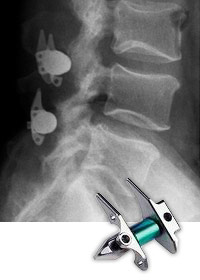Surgical Treatments & Technology
Kyphoplasty
Kyphoplasty is a revolutionary treatment for osteoporotic vertebral compression fractures. It quickly relieves the sufferer from this painful condition. Allowing the patient to return to an active lifestyle, reduces the sequelae of prolonged immobilization, such as bedsores, pneumonia, urinary tract infections, and generalized deconditioning. Kyphoplasty is “minimally invasive”, meaning that the incisions used are only 5 millimeters in length. Many patients can go home on the same day as the procedure. During this procedure, a small incision is made and a needle is placed into the fractured vertebral body. A balloon is then placed into the bone and inflated. The balloon is removed and bone cement or “glue” is injected into the bone to stabilize and buttress it. Most patients experience immediate relief from their pain.
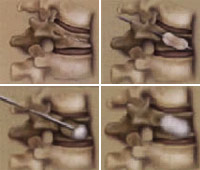
Artificial Disc Replacement
In this procedure, a painful disc is completely excised and replaced with a metal and polyethylene disc. The same technology used to manufacture artificial knees and hips was used to develop this prosthesis. It is hoped that by preserving motion in the spine, these implants will protect the remainder of the spine from degenerative arthritis (degenerative disc disease). We perform both cervical (neck) and lumbar (back) total disc arthroplasty.
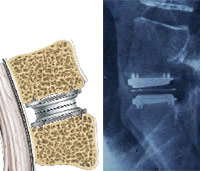
Minimally Invasive Surgery
Many spinal conditions can be treated with minimally invasive surgical techniques. Small incisions, often less than one inch in length, are made. Special instruments are used to perform the procedure. The most commonly performed operation that is minimally invasive is the micro-diskectomy, where a herniated disc that is pinching a nerve is removed. The benefits for the patient are that pain is decreased and recovery is hastened.
eXtreme Lateral Interbody Fusion (XLIF®)
A minimally disruptive surgical technique in which the surgeon approaches the spine from the side of the patient’s body, rather than the front or back as in traditional spine surgeries. This side (lateral) approach can reduce the risk of injury to muscles, nerves, and blood vessels.
The XLIF technique can provide relief to patients who cannot tolerate traditional open-back surgery due to increased risks of longer anesthesia time, greater blood loss, longer hospitalization, and slower recovery. XLIF surgery is a less disruptive alternative for patients who have lived with back or leg pain through years of various failed treatments, including steroid injections, physical therapy, and pain medication.
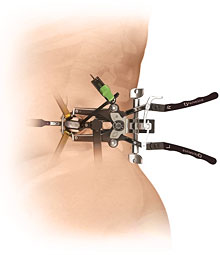
The Maximum Access Surgery Posterior Lumbar Interbody Fusion (MAS® PLIF) Procedure
The PLIF (Posterior Lumbar Interbody Fusion) technique attempts to eliminate instability in the back and pain in the lower back and lower extremities. During the procedure, the damaged disc is removed from between two vertebrae in the lower back (the lumbar region). The vertebrae are then fused together to reduce motion.
Traditionally, a PLIF is performed by making a midline incision in the patient’s back. The attached muscles are then pulled back and laterally (to the side) to allow sufficient exposure for the surgeon to place pedicle screws for fixation. This often results in postoperative approach-related muscle pain and denervation (loss of nerve supply).
In general, the minimally invasive PLIF procedure results in a shorter recovery and a faster return to normal activities compared to a traditional procedure.
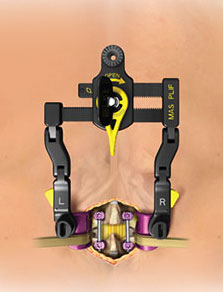
Cervical Spine Surgery
The cervical spine is the neck region, which consists of 7 bones or vertebrae. We perform the following operations:
Lumbar Spine Surgery
Lumbar surgery refers to any type of surgery in the lower back or lumbar spine. We perform the following operations:
- Microdiscectomy
- Laminectomy
- Laminectomy and Fusion
- Direct Lateral Fusion (XLIF)
Bone Morphogenic Protein
Spine fusion surgery causes two or more vertebrae to heal together so that painful motion is eliminated. This operation usually relies on bone harvested from the iliac crest (pelvis bone) to promote healing. Some patients experience pain from the incision that is used to remove the bone from the pelvis. In certain circumstances, a newly available, genetically derived, bone growth factor can be used instead of the patient’s own bone. BMP is currently approved for anterior lumbar inter-body fusion.
X-Stop
Interspinous spacers such as the X-Stop device are placed between the spinous processes of the spine in a minimally invasive fashion. Pain from spinal stenosis can be relieved by indirectly decompressing the spinal canal. The X-Stop device is pictured on the right, along with an X-ray showing the X-Stop in place.
